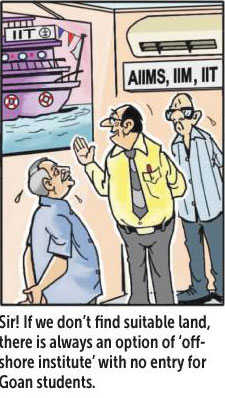25 Apr 2019 | 05:29am IST
Dropping voter turnout a matter of concern
A voting percentage of 74.64 in the Lok Sabha elections for Goa is way short of the targeted over 80 per cent. For Goa, a highly literate State, where accessibility from home to the polling station is easy, this reduced turnout from five years ago calls for some measure of introspection.
The voting percentage has been falling rather consistently since seven years ago, when the percentage for the Assembly elections had touched 81.79 per cent. Just two years later, when Goa voted in the Lok Sabha polls in 2014, the percentage had been 76.86, a drop of five percentage points. In the Assembly elections on 2017, the voting percentage was 78.88 per cent, again less than of the previous Assembly election, but higher than the 2014 LS polls.
The poll percentage that Goa registered on Tuesday is the lowest since 2012, and the falling trend needs to be analysed to avoid it plunging lower. There was an aggressive drive by the election authorities that saw a host of election icons moving around the State in an attempt to enthuse voters to get out and vote. A media campaign, including on the social media, was also run. Facilities for senior citizens and persons with disabilities had been announced. All this does not appear to have led to a spurt in voting. As the Chief Election Officer said, there was much enthusiasm among the senior citizens who went out to vote, but the reason he gave for the lower than expected turnout was the long weekend and the holiday season.
For a moment let’s leave aside percentages and look at the numbers. Of Goa’s 11,35,811 voters, according to the figures released by the election office 8,48,640 persons voted, which means that 2,87,171 didn’t cast their vote. Surely 2.87 lakh persons weren’t all out of the State holidaying on election day. There have to be other reasons for abstaining from the voting process. It begs the question of whether a rather large chunk of the population is taking a rather casual attitude to voting, preferring instead to critique the system in the time between elections rather than playing a role in the democratic process by exercising their franchise.
When compared with the voter turnout in the three phases of the Lok Sabha election, Goa’s 74.64 is not low, as it is way higher than the national average that is in the mid-60’s. It is way better than some States like Bihar and even Gujarat this year, but the fact that there is a declining trend is a matter of concern and the reasons for this need to be explored and addressed, before the rate drops further. Goa is a highly politically motivated State. Politics is debated at all social gatherings, and now also on social media. The apathy to the election process therefore does not conform to the State’s highly vocal political discussions that take place, not just at election time, but throughout the year. So why the reluctance to vote?
One reason that political scientists give for dropping rates in voter turnout is the trust deficit that exists between those who govern and those who are governed. Goa in recent times has seen a number of movements aimed at the government, all exposing the functioning and the policies. Is the drop in the voter turnout a reflection of the disgust that has seeped in among voters to the manner in which politicians are taking the people for granted? No amount of voter awareness will make people exercise their franchise if they have no faith in the government. Here, it is the government that will have to change its way of dealing with the people, it will have to be responsive to people’s needs to reassure them that their needs are being dealt with.
